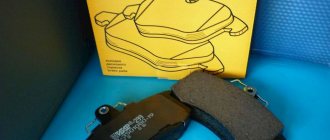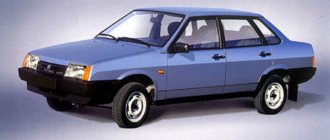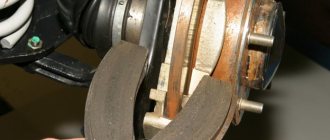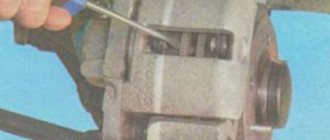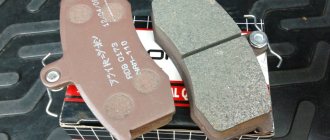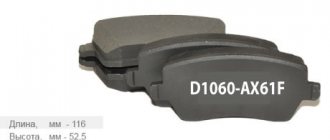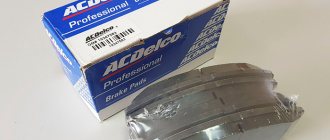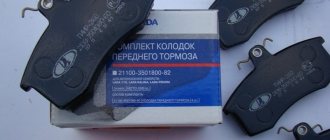Many car owners, when purchasing the next set of spare parts for maintenance, do not even suspect that replacing brake discs is the same mandatory procedure as installing new pads. Sometimes it comes to the point that the next time you press the pedal, an important element of the brake system simply falls apart and the car, control over which is lost at that moment, gets into a serious accident.
- Replacement of VAZ brake discs. Video:
- When to change brake discs? Video:
- Useful tips
How to avoid such situations and breakdowns associated with failure or damage to critical parts? Let’s clarify this issue by covering the problem in as much detail as possible, and give some useful recommendations.
There is a similar article on this topic - Grooving brake discs with your own hands.
Limit resource
With each contact with the pad, the disc wears out, although its thickness does not decrease as rapidly as the thickness of the friction linings. And yet there comes a time when wear exceeds acceptable limits. The minimum permissible thickness of the brake disc must be indicated by the manufacturer in the technical specifications of the car.
Even for one model, it may vary depending on the modification. For some cars, the resource is enough for 100 thousand km or more.
For others, replacement time occurs after several tens of thousands of kilometers. Most car manufacturers stipulate replacement times for important components. But these are approximate figures, since many factors influence the rate and nature of wear.
Influencing factors
The choice of pads used for replacement during maintenance has a serious influence. Most manufacturers have their own recipe according to which friction linings are made. The physical characteristics of these pads may vary.
It is optimal to purchase discs and pads from the same manufacturer. Their parameters are selected in such a way as to ensure optimal braking while maintaining the overall resource of the node.
Much depends on the operating conditions of the equipment and the driver’s driving style. Affects the wear and condition of the entire system as a whole. Malfunctions that arise sometimes significantly reduce the service life of parts. The necessary recommendations are required to be given by employees of dealership centers. But you should not completely rely on their integrity.
To know when to replace brake discs, it is recommended to regularly inspect them and measure their thickness. Before starting measurements, it is necessary to clarify the vehicle configuration option. ventilated brake discs and conventional ones can be installed on the same car They differ in size.
Important! Measurements should be taken not along the edge, where a side often forms due to wear-out, but along the plane of the disk.
The wear of the surface on which the pads press is uneven. This is due both to the structure of the friction linings themselves and to the entry of foreign objects such as small stones into the gap between the pad and the disc. To prevent this from happening, foreign objects must be removed in a timely manner. If the issue is in the structure of the friction linings, you should refuse to use parts from a less than conscientious manufacturer.
Dangerous overheating
Car owners often wonder why the brake discs on their car get hot . In fact, periodic increases in temperature are normal.
The more intense the braking, the higher the heating. But if the temperature remains high even after prolonged movement with the pedal released, this means that the calipers do not release the brakes due to souring of their pistons or guides.
In this case, the wear of parts accelerates sharply. The fault must be corrected immediately. Sometimes it is enough to clean the parts from dirt and rust. But repairs and even complete replacement of the unit may be required.
What affects wear?
There are no clear parameters on the issue of wear. Each manufacturer provides its own characteristics and digital parameters regarding this. There are tables for different makes and models of cars, as well as numerical data for each model within the same brand. Various indicators are related to engine power, the weight of the car, as well as the consequences of all the physical forces acting on the car during braking.
Possible options
The design features of the braking system depend on the intentions of the developers and the results obtained after preliminary calculations and tests. This affects the design of individual parts, their dimensions and material of manufacture. To increase braking efficiency, a vehicle can be equipped with:
- Vacuum boosters that increase the pressure in the hydraulic drive of the system. If they are available, a multi-ton machine can be stopped by lightly pressing the pedal.
- High efficiency calipers providing high clamping force on the pads.
- Perforated brake discs. Thanks to the presence of holes or slots on the working surface, the part itself becomes lighter and the coefficient of friction between the friction linings and the disk increases significantly. At the same time, pad wear accelerates. For this reason, this solution is resorted to if other ways to increase the efficiency of the brakes have been exhausted.
- Carbon wheels. The wide distribution of parts made of carbon with undoubted advantages is hampered by the high price of this material. Such components can currently only be found on very expensive cars.
Important! If you have a desire to make independent changes to the design of the brake system, remember that this can only be done after agreement with the equipment developer. Otherwise, the converted car can only be used on sports tracks.
If technical control authorities identify the fact of operating a car with modified brakes on public roads, according to the current legislation, the violator will not even face a fine, but a real prison sentence.
Car owners who repair the brake system of their car themselves or are simply interested in the design and maintenance rules of the equipment are often interested in the procedure for performing certain works. Let's talk about this too.
Vehicle operation
This is a factor that largely depends on the driver. For example, in winter, while using the car, it is very easy to deform the rear brake disc. As it moves, it heats up, and since it is quite cold outside, serious temperature changes cause the metal to deform. If this happens often enough, repair or replacement is inevitable.
Replacing front brake discs
To successfully complete the job, it is recommended to use a lift or jack in combination with reliable stops. Of course, depending on the specific car model, there are certain nuances. But the general sequence of actions on most modern machines is as follows:
- Loosen the wheel bolts.
- Raise the car until the tire stops touching the supporting surface.
- Unscrew the bolts completely and remove the wheel.
- We unscrew the caliper cover or (depending on the design) knock out the guides. After this, remove the brake pads.
- Since new pads must be installed along with the new disc, use a flat pry bar to completely recess the caliper pistons. At the same time, we make sure that they move freely and the anthers are intact.
- We unscrew the caliper from the mounting points. To do this, you may have to turn the steering wheel in one direction or another to ensure easy access to the bolts. We remove the caliper and use a wire to hang the suspension arm or car body on the shock absorber strut so that the hoses are free. Sometimes this requires first loosening or removing the clamps holding the hoses in place.
- Unscrew the screw (or screws) securing the disc to the wheel hub. After this we remove the part. It happens that it sticks to the seat on the hub. Then you will have to use a liquid wrench, a hammer and a soft metal drift.
- We clean the seat on the hub from dirt and rust and install the new part in place by tightening the fixing screw(s).
- Degrease the working surface of the disk.
- We fix the caliper in place.
- We install the pads.
- We put the wheel in place.
In fact, there is nothing particularly difficult here. The main thing is to have a good tool and the necessary consumables available. And, of course, hands growing from the right place.
For your information! Parts are changed only in pairs. It is unacceptable to carry out work on only one side of the machine.
When to change brake discs? Video:
Replacing rear brake discs
The nature and order of operations, as a rule, does not differ from work performed on the front wheels. But sometimes you have to get to the mounting points for the calipers from under the car. If you have a lift, this is not a problem. If you only have a jack, you will need an inspection hole.
Although extremely rare, there are car models in which the discs are made integral with the hub. In this case, you will have to replace the entire assembly.
Carefully! After finishing the work, you need to press the pedal several times so that the pads fall into place.
It should be taken into account that at the initial stage, until the pads break in, the braking efficiency will be slightly lower than usual. Some manufacturers of spare parts supply lapping paste with the parts, which should be applied in accordance with the instructions for its use.
How to carry out the work
When replacing disc brakes, the sequence of work must be followed. This must be done on a level surface, preferably in a garage, and prepare a set of tools for fastening in advance; different models use different options - from ordinary bolts to screws with an internal hexagon or star. Step-by-step instruction:
- Place chocks under those wheels that will not be removed to prevent the car from rolling.
- Remove the mounting bolts or nuts on the wheel rim. Raise the car with a jack and remove the wheel. It is dangerous to put a stop and leave the car on a jack.
- Unscrew the cap on the brake fluid reservoir. This will make it easier to press in the brake cylinder.
- When there are fixing brackets, carefully remove them with a screwdriver. Then unscrew the caliper mount. Take a flat-head screwdriver and carefully press in the piston on the brake cylinder.
- If you need to change the pads, the old ones are removed, the installation site is cleaned of dirt, and then new parts can be installed. Reassemble in reverse order.
- When removing the disc, move the caliper to the side and hang it so as not to damage the hose. The bolts must be removed carefully; to do this, first block the hub in a stationary position.
- Clean the installation site from debris and deposits. Replacing the brake disc is carried out in the reverse order. If there is a protective lubricant on it, remove it with a degreaser.
For your information! Carry out work no earlier than half an hour after the trip. All parts of the brake system must cool down.
When installing discs or replacing pads, inspect all elements and, if necessary, replace worn ones. Pay attention to the fasteners and brake hoses; if they are cracked, buy new ones. You can test the system ahead of time from the pit to ensure you have everything you need in advance.
Which brake discs are better?
Of course, there are well-known brands whose product quality has been proven by experience. Among them we can mention Brembo, ATE, TRW. But on the one hand, new players are constantly appearing on the market, supplying products of fairly high quality, and on the other hand, you can find a fair amount of counterfeit parts on sale.
Replacement of rear and front brake pads. - there is more useful information here.
For these reasons, it is not worth trying to make a rating of brake discs , and when choosing spare parts, it is recommended to pay attention not only to the big name of the manufacturer, but also to the overall quality of the product.
Since you won’t be able to analyze the composition of the material from which the part you need is made at home, you should concentrate on the following parameters:
You will be interested in this article - Grooving brake discs with your own hands.
- Exact compliance with dimensions, due to violation of which assembly of the unit may be impossible. Poor balancing of the disc will cause it to run out, the extreme manifestation of which is the pulsation of the brake pedal when pressed. Such components will have to be immediately scrapped.
- Processing quality. It is unacceptable if the parts have burrs, burrs or deep scratches. Conscientious manufacturers do not allow this.
- Compliance with catalog numbers. They must exactly match those specified in the technical documentation or on the website of the company that manufactured the part.
As mentioned above, it is highly advisable to purchase discs and pads from the same manufacturer. In this case, the overall performance of the braking system will be higher, and the components will last longer.
Friction linings that are too soft, working in tandem with a disk made of hard alloy, will quickly wear out. Hard pads, on the contrary, will render a part made of soft metal unusable in a short time.
